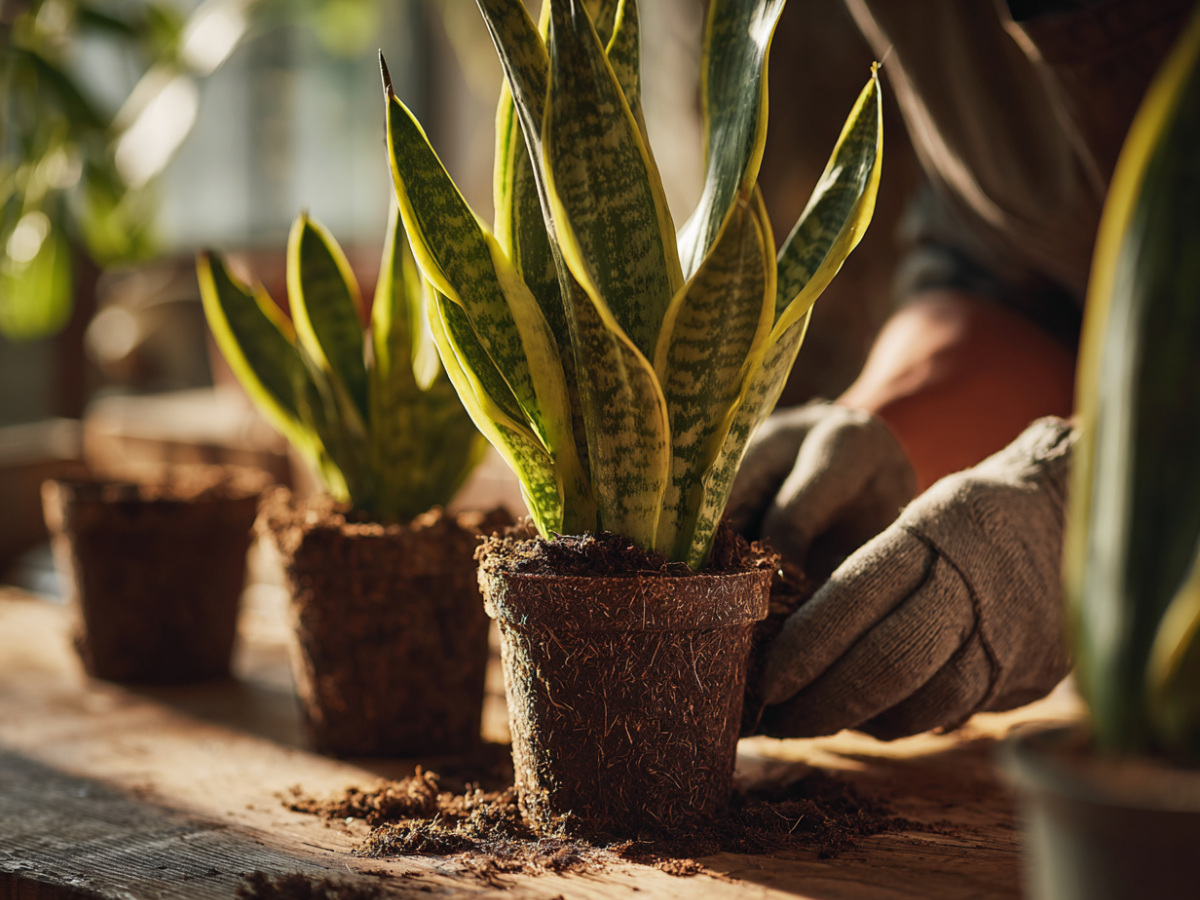Snake Plant Propagation by Division – A Simple Guide to Multiply Your Green Friends
Snake Plant Propagation by Division – A Simple Guide to Multiply Your Green Friends
Introduction – Why Propagating Snake Plants Feels So Rewarding
There’s something magical about seeing your plants thrive, isn’t there? You place a small pot on your windowsill, care for it day after day, and suddenly it rewards you with new leaves and shoots. Few plants capture this joy as easily as the snake plant—also called Mother-in-law’s Tongue.
If you’ve ever wished you could multiply that one strong, glossy plant sitting in your living room, here’s the good news: you can. And you don’t need fancy tools, complicated techniques, or endless patience. Snake plant propagation by division is the most reliable way to create new plants from your existing one.
By the end of this guide, you’ll know exactly when and how to divide your snake plant, the tools you’ll need, the mistakes to avoid, and how to care for your new plants so they flourish. Think of it as not just propagating, but multiplying the happiness your snake plant brings into your home.
What Is Snake Plant Propagation by Division?
Propagation is simply a way of making new plants from existing ones. While many plants can be grown from cuttings or seeds, snake plants respond best to a technique called division.
Division means separating a mature plant into smaller clumps, each with its own roots and leaves. This isn’t just about multiplying plants—it’s about giving them space and energy to grow stronger.
Here’s why propagation by division works so well for snake plants:
- Each new section already has roots, which makes it establish faster.
- It ensures an identical copy of the parent plant—perfect if you love the leaf pattern of your original.
- Unlike leaf cuttings, you don’t wait months for tiny roots to develop.
In short, division is quicker, safer, and more rewarding than other propagation methods.
When Is the Best Time for Snake Plant Division?
Timing matters. If you want your new snake plants to take off quickly, you need to divide them when they’re naturally full of energy.
The best time:
- Spring or early summer – This is when snake plants are actively growing. Dividing during this period means faster root establishment.
Signs your snake plant is ready to be divided:
- The pot looks overcrowded with leaves.
- You notice several new pups (baby shoots) popping out of the soil.
- Roots are circling the pot or poking through the drainage holes.
Avoid propagation in fall or winter. During the colder months, snake plants slow down their growth, making recovery after division much slower.
Tools and Materials You’ll Need for Snake Plant Propagation by Division
Before you start, gather your tools. This will make the process smooth and safe for both you and your plant.
Your Snake Plant Propagation Kit
- Sterilized knife or shears – For cutting through thick roots.
- New pots with drainage holes – So roots don’t sit in water.
- Fresh potting mix – A well-draining cactus or succulent soil.
- Gloves – Optional, but helpful since the sap can irritate skin.
- Clean surface or newspaper – To keep your workspace neat.
Pro tip: Always sterilize your cutting tools before use. Dirty blades can introduce infections that may harm your new plants.
Step-by-Step Guide: Snake Plant Propagation by Division
Now comes the exciting part—actually dividing your snake plant! Follow these steps carefully, and you’ll soon have multiple healthy plants.
Step 1 – Remove the Plant from Its Pot
- Gently tilt the pot and slide the rootball out.
- If it’s stuck, tap the sides of the pot or squeeze gently to loosen.
Step 2 – Identify Natural Divisions
- Look for clusters of leaves (pups) attached to the root system.
- Each section you separate should have both leaves and roots.
Step 3 – Separate the Roots
- Using your hands, gently pull apart the sections.
- If roots are tightly bound, use your sterilized knife to cut them.
- Aim for divisions with at least 2–3 healthy leaves and a good root system.
Step 4 – Replant the Divisions
- Place each division into a new pot filled with fresh, well-draining soil.
- Position the plant upright and press the soil gently around the roots.
- Water lightly—just enough to settle the soil.
Step 5 – Care After Division
- Keep your plants in bright, indirect light.
- Avoid heavy watering in the first 2–3 weeks.
- Allow your new plants to adjust before fertilizing.
Quick checklist:
- Don’t bury leaves too deep.
- Use breathable pots like terracotta for better airflow.
- Place the new plants in a warm room (65–85°F / 18–29°C).
Snake Plant Division Care Schedule
Here’s a simple table to help you care for your divided plants at every stage:
| Stage | What to Do | Frequency | Notes |
|---|---|---|---|
| First Week | Light watering | Once | Soil should be slightly moist, not soggy |
| Weeks 2–4 | Provide indirect sunlight | Daily | Keep away from harsh midday sun |
| After 1 Month | Resume normal care | Every 2–3 weeks | Let soil dry completely between watering |
| After 2 Months | Fertilize lightly | Monthly | Use diluted cactus fertilizer |
Common Mistakes in Snake Plant Propagation by Division
Even though this method is simple, beginners often make a few mistakes. Avoid these, and your plants will thrive:
- Overwatering – Snake plants hate sitting in soggy soil. Always let the soil dry before watering again.
- Dividing too early – Pups without roots won’t survive on their own. Wait until they’re mature enough.
- Using dull or dirty tools – This increases the risk of infections.
- Placing in poor lighting – Snake plants tolerate low light, but freshly divided ones need bright, indirect sunlight for recovery.
Benefits of Snake Plant Propagation by Division
Why should you choose division over other methods like leaf cuttings? Here are the top benefits:
- Faster results – Since each division already has roots, growth is quicker.
- Healthier plants – Dividing helps reduce overcrowding, giving each plant more space to grow.
- Cost-effective – You can expand your indoor garden without spending extra money.
- Perfect for sharing – Propagated plants make thoughtful gifts for friends and family.
FAQ: Snake Plant Propagation by Division
Can all snake plants be propagated by division?
Yes, whether you have Laurentii, Zeylanica, or Moonshine, all varieties can be divided as long as they have pups with roots.
How long does it take for divided snake plants to grow?
With the right care, you’ll usually see new growth within a few weeks to two months.
Is propagation by division better than leaf cuttings?
Absolutely. While leaf cuttings take months to root, divisions already have established roots, making them stronger and faster to grow.
Do I need special soil for snake plant propagation?
Yes—choose a well-draining mix such as cactus or succulent soil. Regular garden soil holds too much water and can cause rot.
How many times can I divide a snake plant?
As often as the plant produces pups. Just make sure each section is large enough to survive on its own.
Conclusion – Multiply the Joy of Your Snake Plant
Snake plants aren’t just survivors—they’re sharers. With a single pot, you can create a thriving collection for yourself, brighten your friends’ homes with gifts, or simply enjoy the satisfaction of nurturing new life.
By mastering snake plant propagation by division, you’re giving your plant space to grow while multiplying its beauty across your home. And the best part? You don’t need a green thumb—just patience, a sharp tool, and a little love.
So go ahead—take a closer look at your snake plant today. Maybe it’s already ready to share its abundance with you. Why not give it a try and see just how rewarding it feels to multiply your green companions?


0 Comment